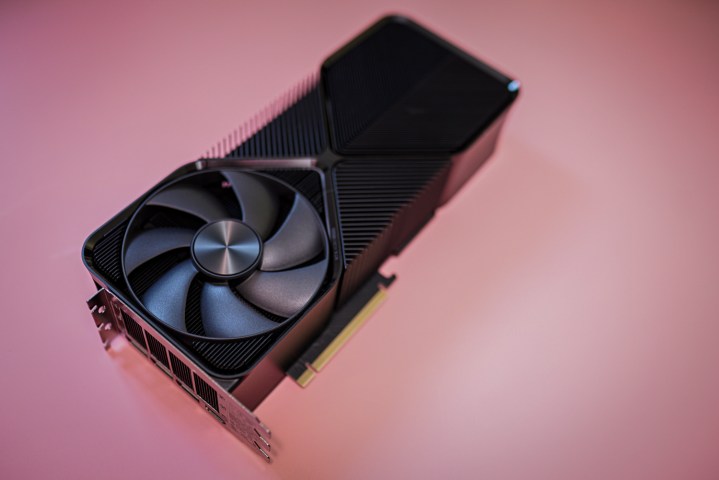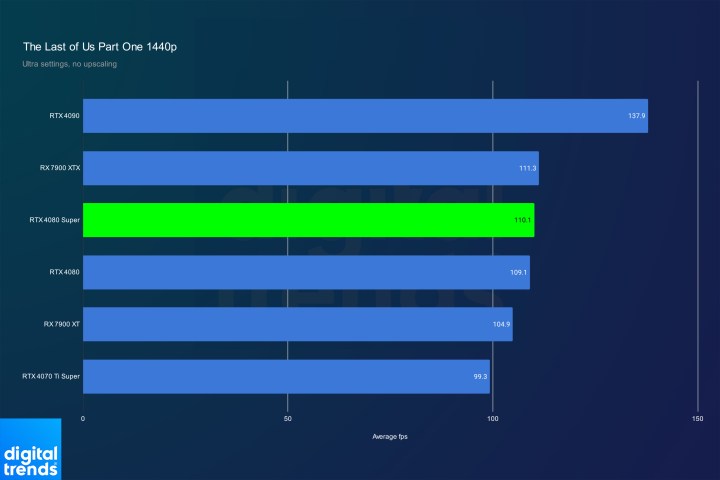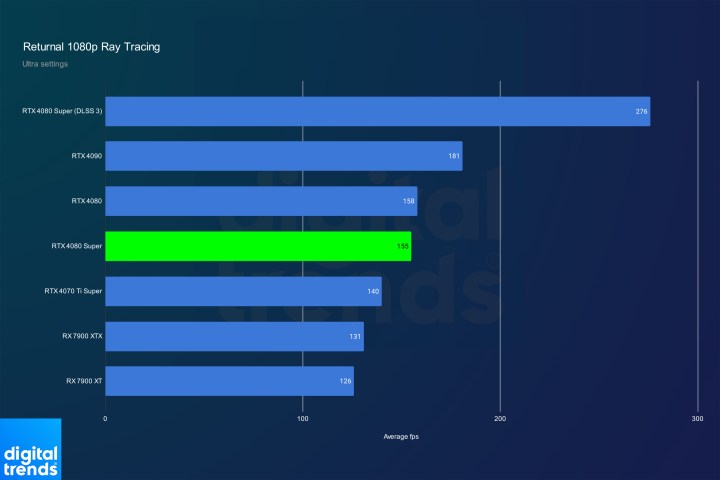
- Great 4K performance
- DLSS 3.5
- Exceptional ray tracing performance
- Very power efficient
- $200 price drop
- Little improvement compared to base RTX 4080
- Power adapter can be unsightly
- Prices may not hold at $1,000
Nvidia owes everyone an apology, and that’s exactly what the RTX 4080 Super feels like. It’s a recognition of how important value is among the best graphics cards, and how the original model fell woefully short of hitting that value mark.
The RTX 4080 Super isn’t an exciting GPU release; I’ll get that out of the way upfront. It doesn’t move the needle for performance compared to the base model, just like its specs suggest. It does, however, make the card much more attractive in terms of value, not only compared to Nvidia’s own lineup, but also to the competition from AMD.
Nvidia RTX 4080 Super specs

The RTX 4080 Super isn’t all that different from the base RTX 4080. A quick breakdown of specs shows that the two GPUs are identical outside of core count. The RTX 4080 Super has a 5% bump in cores, allowing it to fully take advantage of the AD103 GPU. It’s a very minor bump, especially on the heels of the RTX 4070 Super and RTX 4070 Ti Super.
| RTX 4080 | RTX 4080 Super | |
| GPU | AD103 | AD103 |
| Interface | PCIe 4.0 x16 | PCIe 4.0 x16 |
| CUDA cores | 9,728 | 10,240 |
| Boost clock | 2,505MHz | 2,505MHz |
| Memory | 16GB GDDR6X | 16GB GDDR6X |
| Memory speed | 22.4 Gbps | 23 Gbps |
| Memory bus | 256-bit | 256-bit |
| TDP | 320W | 320W |
Everything else is the same — same memory interface, same clock speed, and the same power draw. Given that there’s a higher CUDA count, however, there’s the same small bump to Tensor and ray tracing cores. That helps the RTX 4080 Super gain a slight edge in ray tracing applications, which I’ll get into later.
Specs aren’t what’s important for this GPU, though. It’s safe to think of it as a rebranded RTX 4080, and my benchmarks back up that assumption. The important note here is the price. The RTX 4080 Super is releasing for a list price of $1,000, while the base model originally released at $1,200 and has held steady at that price since.
That’s the defining difference between the RTX 4080 Super and the RTX 4080. This Super refresh is replacing the base model, effectively making this a strict price cut.
Synthetic performance

As mentioned. the RTX 4080 Super isn’t much different than the RTX 4080. In 3DMark Time Spy, the Super model is a mere 1% ahead of the base version. That’s well within the variance you’d see even between two identical GPUs. You could run this test a dozen times with each GPU, and they’d trade places constantly.
Call it “statistically insignificant.” If there’s anywhere we should see the average 3% improvement Nvidia claims for the RTX 4080 Super, it’s in a synthetic benchmark. Based on my tests, though, the variability when performance gets this close is too big to overcome, even for a test designed to take variability out of the equation.

That’s only one side of the story. In 3DMark Port Royal, the RTX 4080 Super is ahead by 1.5%. That sounds insignificant — and on the whole, it is — but that’s to the point where you’ll consistently see some improvement over the base model. It’s not a big improvement, but the extra ray tracing cores are at least doing something.
There’s some important expectation setting here, though. Overall, you’re looking at a performance gains in the low single digits, with some games showing no improvement at all. Consider even Nvidia’s claim of a 3% improvement optimistic — this is the RTX 4080, just with the Super badge.
4K gaming

Further proving the point that this is just the RTX 4080, look at my 4K average. The Super refresh is just 1% ahead of the base model based on all of my tests. Once again, I could run these tests several times and get a result where the base RTX 4080 comes out on top.
Rather than belabor that point, let’s take this as a competitive reassessment of where the RTX 4080 fits in the GPU landscape. Its main competition was (and remains) AMD’s RX 7900 XTX. The RTX 4080 Super is around 7% faster on average, including games with ray tracing. That’s a straight win for Nvidia considering the RX 7900 XTX is still selling for $1,000.

Nvidia looks good in Horizon Zero Dawn, especially, where it shows not only an uplift over the base RTX 4080, but also the RX 7900 XTX. That’s the only game I tested where the RTX 4080 Super looks strictly better, however.
In every other game I tested, there’s nearly a flat line across the RX 7900 XTX, RTX 4080, and RTX 4080 Super. In Red Dead Redemption 2, Returnal, and Assassin’s Creed Valhalla, the three GPUs all trade blows within a few frames of each other, and there’s usually even less of a difference than that. This is all fresh data, too — I reran tests on every GPU you see here to make sure it’s all as current as possible.

Resident Evil 4 is the most telling, with less than a single frame of variance between these three graphics cards.
What’s surprising is that the RX 7900 XTX comes out with a more significant lead in some games. In Cyberpunk 2077, Forza Horizon 5, and The Last of Us Part One, it leads by a few frames. It’s not a lead that changes the gameplay experience much, mind you, but it’s much more movement than we can see in other games.
It also exposes one of the RTX 4080 Super’s key elements. It’s mostly evenly matched with the RX 7900 XTX, but AMD’s GPU comes out ever so slightly ahead in some games. The factor working in Nvidia’s favor is ray tracing, which I’ll dig into later.
1440p gaming

And so the descent begins. Down at 1440p, the RTX 4080 Super is 1% faster than the base RTX 4080, but that’s a rounding technicality. It’s actually a whole 0.7% faster; it’s identical. More relevant is the RX 7900 XTX, which falls behind once again. The RTX 4080 Super is 7% ahead, mainly on the back of ray tracing.
There’s a little more movement at 1440p compared to 4K. In Resident Evil 4, for instance, the RTX 4080 Super is a couple frames ahead the base model, as well as 4% ahead of the RX 7900 XTX. Horizon Zero Dawn is once again a good showcase for performance gains, with the RTX 4080 Super coming out nearly 8% faster than the RX 7900 XTX.
Still, most games don’t show much a difference. Such is the case in Red Dead Redemption 2, Assassin’s Creed Valhalla, and The Last of Us Part One. You can swap these GPUs out in a blind test, and it would be impossible to tell the difference between them.
And once again, the RX 7900 XTX holds some compelling leads in a few titles. Most notably, it shows an improvement of a few frames in Forza Horizon 5, Returnal, and Cyberpunk 2077. The latter is the most surprising, as even AMD’s cheaper RX 7900 XT is able to match the two RTX 4080 models, while the RX 7900 XTX shoots ahead.
The games where the RTX 4080 Super leads have shifted, the conclusion hasn’t. The RX 7900 XTX remains slightly faster overall, even if the lead is just in a handful of games. But the RTX 4080 Super is making up ground in its overall performance with ray tracing, which is an area AMD still struggles in.
1080p gaming

There isn’t much to talk about at 1080p for a GPU that costs $1,000. With how performant the RTX 4080 Super is, you’re not just wasting money if you run this GPU at 1080p — you’re actively forcing your system to run in a bad state with a nasty CPU bottleneck. At this resolution, the RTX 4080 Super maintains a lead of just 1% over the base model.
Interestingly, the RTX 4080 Super is close to around 10% faster than the RX 7900 XTX at this resolution. That’s likely exposing some of the game imbalances in how they handle the GPU and CPU at this resolution, given that it’s a larger gap than what we see at higher resolutions. It’s not exactly relevant, though, considering you shouldn’t be using a $1,000 GPU down at 1080p anyway.
Ray tracing and DLSS 3.5
It shouldn’t come as a surprise that the RTX 4080 Super leads the RX 7900 XTX in ray tracing performance. Sometimes the leads are massive, such as in Cyberpunk 2077. Without upscaling, the RTX 4080 Super is providing console-like performance at 4K. The RX 7900 XTX can’t even manage 20 frames per second (fps).
Returnal is a bit lighter in terms of ray tracing demand. The RTX 4080 Super leads once again, but it’s not as far ahead. Still, it’s able to clear the 60 fps mark at 4K, while the RX 7900 XTX struggles to hit it.
Stepping even further down to Resident Evil 4, there aren’t a ton of differences between the RTX 4080 Super and RX 7900 XTX. It’s a good reminder that not all ray tracing implementations are going to tax your GPU as much as something like Cyberpunk 2077.
Still, on the whole, Nvidia leads in ray tracing with the RTX 4080 Super. More importantly, the card has access to DLSS 3.5. You can see how big of a difference DLSS Frame Generation makes in Cyberpunk 2077 and Returnal, and although AMD now has its FSR 3 feature with frame generation, it’s only available in a handful of games.
The big boost for the RTX 4080 Super, in particular, is Ray Reconstruction. This is only available in Cyberpunk 2077 and Alan Wake 2 right now, but it completely changes the visuals of those two games. With full path tracing at the helm, it feels like the premium 4K gaming experience Nvidia has been selling since 2018. The RTX 4080 Super brings that experience to life in a way the competition just can’t.
Nvidia has been building its features around DLSS for the past few years, and the RTX 4080 Super is the perfect showcase of how all of those features come together. You may not need to turn on DLSS in every game, but it makes all the difference when those premier titles like Alan Wake 2 or Cyberpunk 2077 roll around.
Should you buy the RTX 4080 Super?

Nvidia has changed the math a lot with the RTX 4080 Super. It doesn’t provide much of an uplift over the base model, but it didn’t need to. It brings the price down, and that makes this GPU a lot more compelling.
AMD’s RX 7900 XTX puts up a good fight, but it ultimately comes up short. If it stays at the same $1,000 list price it has held steady at, AMD’s flagship isn’t going to last long. I suspect it will rapidly drop in price once the RTX 4080 Super is out for a few weeks. Right now, though, Nvidia has the clear competitive win.
More interesting is the dynamic between the RTX 4080 Super and the RTX 4090. It’s clear the RTX 4090 is faster — much faster, as you can see in my benchmarks — but it’s also much more expensive at $1,600. When the original RTX 4080 released, it made sense to save up some extra money and get the RTX 4090 because it’s so much faster. With the RTX 4080 Super coming in at a much lower price, that math changes. It finally feels like the RTX 4080 has its place.
And that’s probably the most impressive thing about the RTX 4080 Super. Throughout this generation, Nvidia has struggled to find the correct place for its GPUs among high-end gamers, with most cards missing on the relationship between price and performance. The RTX 4080 Super, underwhelming as it may be compared to the base model, brings those scales back in balance.




























